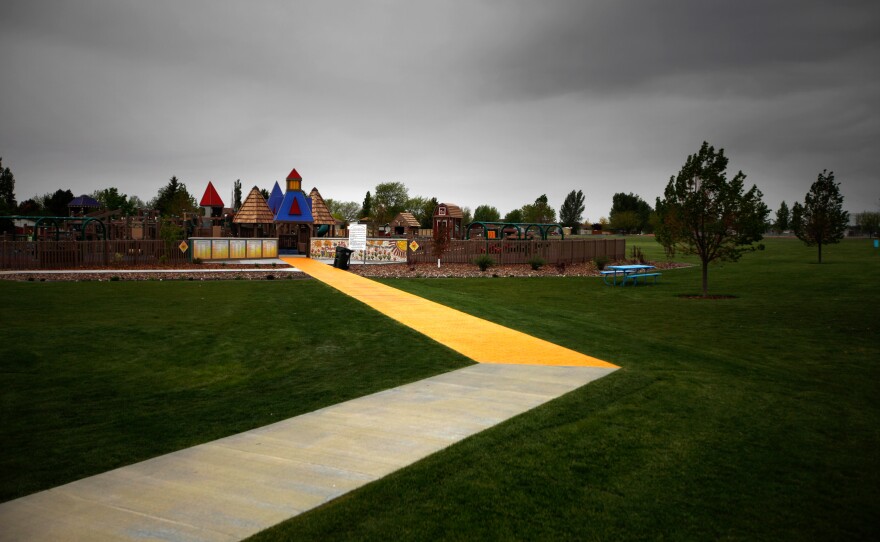
These include drums, chimes and other things that make noise or music.

It's easier for parents and caregivers to monitor children in a playground with only one way in or out, reducing the likelihood that they'll exit without being noticed.

A fence contains children within the playground and keeps them away from outside hazards such as roads, drop-offs and bodies of water.

Ramps are required when play structures have more than 20 elevated play components, and they must connect to a quarter of them. An elevated ramp can't rise more than a foot, and it can't rise more than an inch for every foot in length.

A transfer platform is a low step that allows someone using a wheelchair to transfer out of it onto the playground equipment. It should have an unobstructed side so that the wheelchair can ride up beside it, and should have handrails for grabbing. Steps that follow, to climb the structure, should be no more than eight inches high.

Smooth, poured-in-place surfaces are considered the most accessible. Engineered wood fiber and rubber tiles can also meet the standard. Playground surfaces must be resilient enough to act as a cushion when a child falls.

Some playgrounds include information in Braille for those with visual impairments. Other qualities that may appeal to sight-impaired users include textured materials and fragrant gardens.


Janna Espinoza's daughter Coraline has hearing loss, cerebral palsy, epilepsy and developmental delays. Nearly 2 years old, she can't sit up, stand, creep or use her hands as a typically developing child does.
Coraline is among an estimated 6.4 million children in the U.S. with a disability. And for these kids the simple ritual of playing outside can get very complicated.
"My daughter can't do very much at a typical playground, except watch her older sister play," says Espinoza. "Playgrounds are a depressing place for us."
On a typical playground, danger lurks just about everywhere.
"The infant bucket swings are not safe," explains Espinoza. "She can't go down the slide. She can't play in the sand unless she is on her stomach."
Finding a place to play is a big challenge for children like these, and their parents. Sometimes, they must create one.
Espinoza's community worked for a year to raise money for Tatum's Garden, a playground in Salinas, Calif., designed for everyone to enjoy.
It's one of 1,222 playgrounds in 45 states and 741 cities listed in the Playgrounds for Everyone app. NPR has spent the last year crowdsourcing the list. (These totals do not include more than 400 City of Chicago playgrounds that were just submitted, which we are in the process of adding.)
Promoting 'Active Play'
Outdoor time, motion and social interaction are crucial for development in all children, according to Angela Hanscomb. She's a pediatric occupational therapist who runs an outdoor camp in New Hampshire, using nature as both prevention and treatment for sensory development issues.
"Movement and play are important for both atypical and typical children," she says.
For example, take the simple act of moving your head off the vertical axis, by hanging upside down, spinning or swinging. This kind of action helps develop what is called the vestibular system. That means it's giving the little hair cells inside our inner ear important input, helping us develop awareness of our own midline and shape. This, in turn, is crucial for walking or even for balance when sitting.
"The vestibular system helps support all your other senses," says Hanscomb. "If you don't have a good idea of where your body is in space, you aren't safe."
Research suggests active play can be helpful for children diagnosed with ADD, anxiety, autism, or other emotional or sensory issues. Spinning and experiencing centrifugal force, Hanscomb says, affects the limbic system, and can be very calming. She says kids who display repetitive motions like rocking or fidgeting may be seeking vestibular input that is otherwise missing.
Unfortunately, children with challenges may get less outdoor playtime than others, for safety, social or other reasons. A widely cited 1991 research article suggested that physically disabled kids could be thought of as experiencing a secondary disability arising from "play deprivation."
In recent years, awareness has been growing of the need for "inclusive" or "accessible" playgrounds, such as those tracked by the NPR app.
There are lots of design innovations: Broad, flat ramps that can accommodate wheelchairs or walkers to get to the top of play structures. Sand tables at wheelchair height. Large swings with back rests and straps for kids who don't sit unassisted. "Cozy spots" for children who need time out from all the distraction and noise.
At Tatum's Garden, says Espinoza, "My youngest daughter is able to swing on the accessible swings for the first time. She can army crawl herself through a tunnel in the toddler section. There are many features throughout that she can try to twist or turn, watching balls drop, or cogs spin. Her big sister gets to play at an amazing playground, and I get to let our youngest explore in her own way."
Copyright 2014 NPR. To see more, visit http://www.npr.org/.






